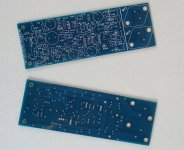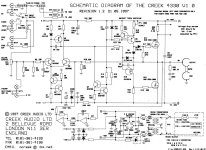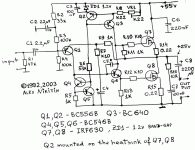The first generation vertical devices like the above D series were much lower gm than modern parts and far better behaved in the linear region with SOAR. There is no modern equivalent to my knowledgeAs not everyone agreed I was a bit confused between vertical and lateral mosfets.
Luckily it is all clearly explained in the 1985 Hitachi Power Mosfet Databook (link here).
In a nutshell:
D-series are vertical mosfets (e.g.2SK346-2SJ102)
S-series are lateral mosfets (e.g.2SK134-2SJ49)
See attached figure and table for more info.
Hi,
just curious did anyone tried to A/B with and without capacitor across LTP trimpod (between emitters of LTP transistors)? How this capacitor affects sounding? It is very rare to see 100uF in this position, no one seems to use this...
This capacitor helps to increase the open loop gain of the amplifier and to reduce the distortion of the closed loop gain.
From the JLH article, concerning C13 and R4 with J1:how J1, C13, R4 and positive feedback R21, R25 work. Comments welcome.
"they form a DC feedback, used to regulate the input current supplied to the input long-tailed pair so that the output voltage at the collector of Q5 is stabilized".
R21 and R25 adjust the positive feedback ratio to increase the open loop gain of the amplifier.
It's an unusual circuit for sure. I think J1, C13, R4 are used to adjust the right end of R21 to be at near gnd; like a dc servo. R25 is a mystery...it doesn't provide much PFB at all. Curious.I built this amp with success at the time but I always had some difficulties to understand how J1, C13, R4 and positive feedback R21, R25 work. Comments welcome.
The circuit as a whole looks marginally stable.
Off ?Great. But how can you tell it is "perfectly stable"?
By testing, on differents loads (resistive, capacitive, etc.) and also on different real loudspeakers etc,Great. But how can you tell it is "perfectly stable"?
I think one has to define what is stable. Is it like a chair with four feet and one is a little shorter. One may argue it is not stable, but the chair does not fall over. In an amplifier, what is stability? Is it thermally running away, does it oscillate with some weird load, does it distort severely, does the devices break down or latch up, does it clip symmetrically, does it produce a clean square wave into any load, does the output vary up and down, is the output power constant, does it stop working after a while, does it perform identically under any temperature conditions? Stable is a very nebulous concept.
Last edited:
- Home
- Amplifiers
- Solid State
- Rebuilt of Linsley Hood MosFET amplifier from Wireless World 1982



